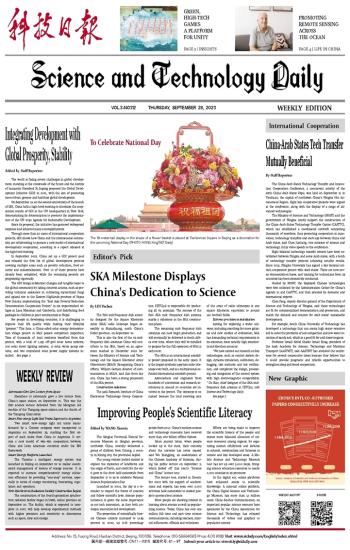
 Promoting Remote Sensing Across the Ocean
Promoting Remote Sensing Across the Ocean Green, High-tech Games: A Platform for Unity
Green, High-tech Games: A Platform for Unity Integrating Development with Global Prosperity, Stability
Integrating Development with Global Prosperity, Stability To Celebrate National Day
To Celebrate National Day China-Arab States Tech Transfer Mutually Beneficial
China-Arab States Tech Transfer Mutually Beneficial SKA Milestone Displays China's Dedication to Science
SKA Milestone Displays China's Dedication to Science WEEKLY REVIEW
WEEKLY REVIEW New Graphic
New Graphic Improving People's Scientific Literacy
Improving People's Scientific Literacy
The Qinghai Provincial Natural Resources Museum in Qinghai province, northwest China, recently welcomed a group of children from Datong, a county in Xining city, the provincial capital.
The young visitors looked excited to explore the mysteries of landforms and the origin of Earth, and credit for the visit goes to the drive held nationwide from September 17 to 23 to celebrate National Science Popularization Day.
Launched in 2004, the day is a reminder to respect the forces of creation and follow scientific laws. Science popularization is given the same importance as sci-tech innovation, as they both underpin innovation-led development.
The proportion of scientifically literate Chinese citizens increased to 12.93 percent in 2022, up 9.66 percentage points from 2010. China's modern science and technology museums have received more than one billion offline visitors.
Since ancient times, when people looked up at the stars, their curiosity about the universe has never ceased, said Wu Xiangping, an academician of the Chinese Academy of Sciences, during his public lecture on September 2, which kicked off this year's "Science and China" lecture tour.
The lecture tour, started in December 2002 with the support of academicians and experts, has seen over 2,000 activities held nationwide to answer people's queries about science.
More people are showing interest in learning about science as well as popularizing science. Today, China has over one million full-time and part-time science communicators, including teachers, internet influencers, officials and volunteers.
Efforts are being made to improve the scientific literacy of the people and ensure more balanced allocation of science resources among regions, by organizing science exhibitions and lectures in schools, communities and factories in remote and less developed areas. A Mobile Science and Technology Museum tour has set up over 5,000 stops, bringing science education resources to nearly 2,000 counties in 29 provinces.
In the digital era, online platforms have enhanced access to scientific knowledge. A national online platform, the China Digital Science and Technology Museum, has more than 15 million users. China Science Communication, an important popular science resource base sponsored by the China Association for Science and Technology, has released thousands of videos and graphics to popularize science.

 Next
Next



